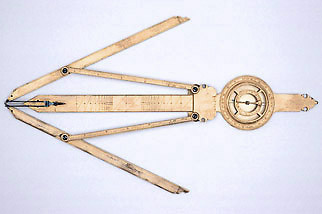
 |
| Catalogue |
 |
 Gunnery Instrument Near one end of the main leg is a compass which can rotate within a circular scale of degrees 0 to 360?, divided to 10, 2 and 1, numbered by 20, and with the four cardinal points named in Latin. The compass bowl is 47 mm in diameter and has an external index to set against the degree scale. Inside the bowl only a meridian line is engraved. Mounted above the compass glass is a horizontal strong gnomon dial for about 48? latitude with a sprung folding gnomon support. The hours run 4 to [12] to 8 and are divided to 1/2 and 1/4. On the remainder of the upper face of the main leg is what appears to be a double scale of polygons, 3 to 15, 15 to 3, each division connected by a diagonal line. On the lower face is a double scale of degrees 0 to 300 in one direction and 60 to 360, mostly divided to 10, 2 and 1 and numbered by 10, except where the scales non-linearity makes the divisions too fine. There is also a scale of 'Wiener Zoll', 0 to 8, divided to 1, 1/4, 1/16 and 1/48, and numbered by 1. Sliding in grooves along the edges of the main leg is a slider with a bevelled edge to read against the scale of polygons. The bevelled edge has a scale 0 to 10 divided across its breadth to 5 and 1 and numbered by 5, so that subdivisions of the polygon scale can be read off by the principle of diagonal divisions. (It is not clear why a decimal subdivision of a polygon would be a useful commodity.) The lower face of the slider has what appears to be an index line to be used in conjunction with the degree scale. Attached to each side of the slider by a blued-steel screw is a leg, one of which carries a scale of 'Romer Zoll', 0 to 51/4, divided to 1, 1/4, 1/16 and 1/48, and numbered by 1; the other has a scale of 'Prager Zoll', 0 to 5 3/4, divided to 1, 1/4, 1/16 and 1/48, and numbered by 1. At the extremity of each of these legs is fixed another leg, again attached by a blued-steel screw. This second pair of jointed legs is unmarked except for outline engraved decoration and the presence of a steel pin at the pointed end of each leg. These two pins are meant to be held by a blued-steel fork spring fixed to the main leg. This arrangement constrains the motion of the jointed legs so that as the slider is moved, the inclination of the legs is varied. However, as currently assembled, the relative inclination of the sprung legs does not match the indicated readings on either the polygon or degree scales. This instrument is very close to the design of Leonhard Zubler's 'geometrical gunnery instrument', published in Nova geometrica pyrobolia. Neuwe geometrische B?chsenmeisterery (1608). It differs principally in having shorter side legs, so that it cannot be used as a pair of large dividers or calipers. The joint linking the side and central legs is also different: whereas Zubler shows all three limbs mounted together on the same axis, in this instrument the two side legs are held in place by the blued-steel spring blades. Provenance: Billmeir Collection (57-84/249). See J. Bennett and S. Johnston, The Geometry of War, 1500-1750 (Oxford, 1996), cat. no. 14. Stephen Johnston |



